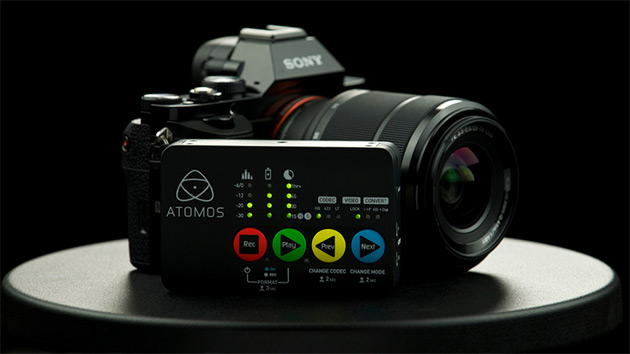Pocket-Sized Recorder Sells for $295, Weighs 8 Oz. with Battery, Media Loaded
Atomos said that it started shipping its Ninja Star field recorder, introduced at NAB, to resellers this week.
The pocket-sized ProRes recorder, billed by the company as the world's smallest, takes a camera's clean HDMI output and writes 10-bit 4:2:2 files in the edit-ready Apple ProRes HQ format. It measures 3.7 inches wide, 2.3 inches tall, and 0.9 inches deep, and weighs 4.6 ounces bare and 8.1 ounces with batteries and media loaded. The package includes a standard 1/4-inch and 3/8-inch mounting plate, but a hot-shoe adapter for mounting on top of the camera is sold separately.
The company is aiming the Ninja Star at POV camera applications, including extreme sports, reality TV, and drone videography. It's also aggressively priced at $295.
"We have priced this for the masses," said Atomos CEO and founder Jeromy Young in a prepared statement. "There is now no reason for professionals with a camera purchased in the last 10 years not to have the best recording available." Atomos noted that the Connect H2S converter ($295) can be used as an interface if necessary to allow the Ninja Star to record HD-SDI sources.
In fact, the device's media is almost as expensive as the recorder itself. Atomos CFast 1.0 cards are available with capacities of 64 GB ($159) and 128 GB ($239), for about 80 minutes and 160 minutes of record time, respectively. A CFast USB docking station is included with the Ninja Star. along with five-hour battery, charger, car adapter, and mounting plate.
Did you enjoy this article? Sign up to receive the StudioDaily Fix eletter containing the latest stories, including news, videos, interviews, reviews and more.










That last sentence needs some spelling-correction to avoid ridicule.
True, true. Craft services should be made aware that the Atomos unit comes with a forking station, although one might expect anything named Ninja to come with a knifing station.
All right. All right. So, the “d” key and the “f” key are beside each other on the middle row of the standard keyboard. Why wouldn’t a spell checker have alerted the typist to this little hiccup? On the other hand, wouldn’t one expect to have a focking station and a mounting plate as paired accessories?
focking right !
I´ve been watching the transition to CFast media by many major players, and I still cannot find any sense to it.
Why using such an expensive card on this device, when 60MB/Sec is more than enough to record ProRes4444? A medium-quality Compact Flash would suffice.
It would be more logical to use such an expensive card when recording raw with light to no compression (again, not the case of this device) but, ¿wouldn´t a good quality SSD be more fit for this purpose? There must be a reason, since both Atomos and Blackmagic (on their new cameras) are migrating away from them. Is it the size? The power draw?
From a manufacturer´s standpoint, It makes sense to use a single card
type across all devices to reduce production costs, but atomos ALREADY sells SSD/HDD recorders!
I know ssd´s vary wildly in performance, and some of them implement technology incompatible with video recording, but even so, they are a much more economic and convenient alternative, while being fairly ubiquitous.
Could someone explain the basis of this decision?